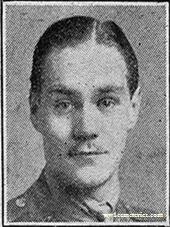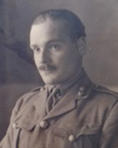Neal, Kenneth Guthrie, son of Lawrence Edward Neal, chairman and man. dir. Daniel Neal & Sons, and Jean Frances Guthrie-Smith, poetess, d. of John Guthrie-Smith, solicitor, of Kelvinside, Glasgow; b. 13 Nov. 1919; adm. Sept. 1932 (H); left July 1938; Magd. Coll. Oxf., matric. 1938; RA in WW2 (Lieut.); killed in action (France) Aug. 1944.
Kenneth Guthrie Neal was born at Glasgow on the 13th of November 1919 the elder son of Lawrence Edgar Neal, chairman and managing director of Daniel Neal & Sons, and Jean Frances (nee Guthrie-Smith) Neal, a poet, of 5, Holland Villas Road, Kensington in London. He was educated at Westminster School where he was up Homeboarders from September 1932 to July 1938. He boxed for the school in 1933. He was a member of the Cricket XI and of the Football XI in 1936, 1937 and 1938 where he played at half back. He was appointed as Captain of the Football XI in 1937. He won the Neale History Prize in June 1938. While at the school he was a keen sportsman, enjoying cricket and middle distance running and was a keen fly fisherman.
On leaving school he and four friends bought an old Sunbeam limousine and drove to Yugoslavia for the summer. He matriculated for Magdalen College, Oxford in 1938 where he was a member of the College Football XI and passed exams for History and Constitutional Law in 1939 and in English in 1940. He did not graduate as he left the College for military service after six terms. He was a poet and a book of his poems, “Poems of This War by Younger Poets” edited by P. Leward was published in 1942.
He attended an Officer Cadet Training Unit before being commissioned as a 2nd Lieutenant in the Royal Artillery on the 2nd of August 1941. He joined 68 Anti Tank Regiment on the 8th of October 1941 and was promoted to Lieutenant on the 1st of October 1942. The Regiment trained in Northern Ireland until the spring of 1944 when it moved to England in preparation for the invasion of France.
On the 24th of June 1944 68 Anti Tank Regiment embarked on board the MT7 “Samuel” at the Royal Prince Albert Dock and disembarked at Le Hamel in Normandy on the 28th of June. They were soon involved in heavy fighting in the Caen area and took part in Operation Charnwood and Operation Pomegranate.
On the 25th of July, the Regiment arrived at Les Saullets where they were to support on an attack towards Landelle and Noyers-Bocage and were then to support the crossing of the River Orne by 176 Brigade, codenamed Operation Bluecoat. A bridgehead was established across the Orne on the 6th of August 1944 with Kenneth Neal and E Troop, 270 Battery crossing the river into it. 271 Battery was positioned on the western slope of the near bank with support from 269 Battery covering their flank. A German counterattack later in the day caused E Troop to fall back to the bridge and further counterattacks over the next two days prevented their comrades from joining them. On the 7th of August E Troop reported that they were making a reconnaissance to find suitable positions for the other two batteries and there was no contact from them on the 8th of August. Kenneth Neal’s commanding officer ordered him, a Sergeant and two other ranks to take a carrier and to see if they could capture an enemy prisoner for interrogation and on the 9th of August 1944 E Troop reported that Kenneth Neal had been captured by the enemy. The following day the Regiment advanced to Ronde Fontaine where they found his body and those of three of his men. His carrier had received a direct hit from a German tank.
He is commemorated on the war memorial at Magdalen College, Oxford.
He is buried at Bayeux War Cemetery Plot XXII, Row D, Grave 11.


